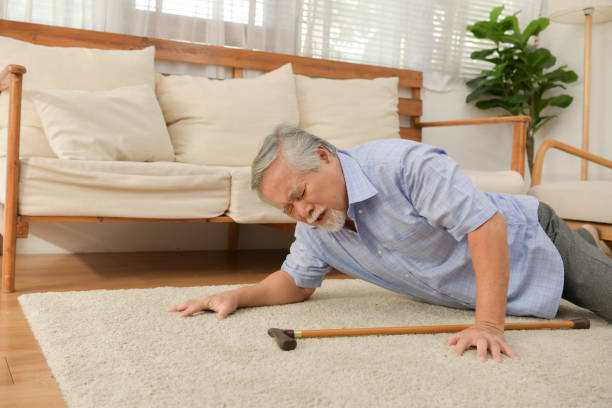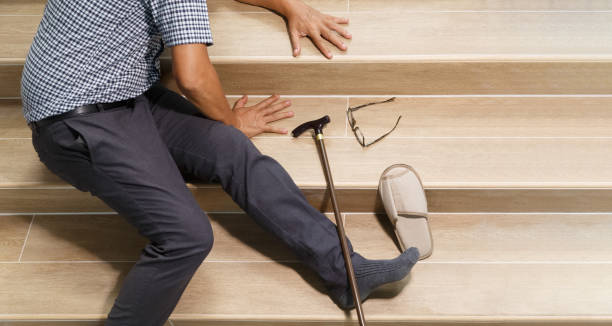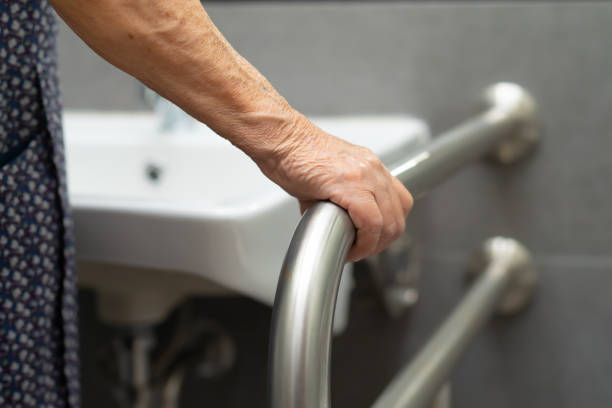Not only are falls embarrassing and painful, they can also be dangerous and life-threatening – especially for seniors. As we age and our bones weaken, we become more prone to serious breaks, as well as hemorrhaging and other complications. Furthermore, because aging causes vascular and neurological systems to become weakened, seniors are at a higher risk of stroke or brain damage from head injury.
Feeling Safe in Your Home
 There is nothing more important to any senior than feeling safe at home, and when it comes to home care, it is vital that the caregiver does everything possible to achieve this goal. At Home & Hearth, our number one priority is providing an environment of care, comfort, and safety for each of our valued clients – and one of the most important aspects of this is helping to prevent falls.
There is nothing more important to any senior than feeling safe at home, and when it comes to home care, it is vital that the caregiver does everything possible to achieve this goal. At Home & Hearth, our number one priority is providing an environment of care, comfort, and safety for each of our valued clients – and one of the most important aspects of this is helping to prevent falls.
Common Causes of Falls
With more than 25% of older adults suffering falls in the U.S. every year, it’s crucial for families and loved ones to step in and help prevent falls from happening as much as possible. Every time a senior falls, their risk for a subsequent fall increases. Here are some of the most common causes of falls for the elderly:
-
Chronic Conditions
Certain illnesses can increase the risk of falling due to how they affect the body. Conditions including Parkinson’s disease, arthritis, and diabetes can cause body systems to malfunction, resulting in lightheadedness, stiffness, or lack of coordination, which, in turn, increases the risk of falls.
-
Home Hazards and Obstacles
 All homes have the potential for obstacles to increase the risk of falling, however, the key is keeping walkways and paths clear. Rugs can slide, curl or fold up, shoes and cords can be tripped over, and items dropped while walking from one room to another can go unnoticed.
All homes have the potential for obstacles to increase the risk of falling, however, the key is keeping walkways and paths clear. Rugs can slide, curl or fold up, shoes and cords can be tripped over, and items dropped while walking from one room to another can go unnoticed. -
Impaired Vision
It’s important to schedule regular eye exams for seniors, ensuring they always have glasses suited to their changing eyesight. Take care to remind your loved one to wear their glasses as recommended by their optometrist. Cataracts, blindness, and partial blindness become more prevalent in seniors as well – and these conditions should be promptly addressed by medical professionals to ensure
-
Medication
Certain prescriptions, like antidepressants, sedatives, and blood pressure medication, can have several possible side effects, including dizziness caused by drops in blood pressure, loss of balance, drowsiness, and reduced mental acuity – any of which increases the risk of falls. Make sure to discuss any medication changes – even medications that are well tolerated for many years can suddenly cause unexpected side-effects.
-
Weakness
Many times when recovering from an illness or injury, seniors will experience increased muscle weakness due to being bed-ridden or simply doing less.. Muscle weakness and lack of mobility can occur for many different reasons, so it is important to be aware of muscle atrophy or a reduced range of motion.
Preventing Falls at Home

Optimizing the home environment for safety is crucial in fall prevention at home for the elderly. This consists of identifying and removing potential hazards, and implementing safety measures including fall prevention socks, and bed wedges to prevent falls.
-
Remove
Be sure to remove as much clutter as possible, including anything in walkways and heavy traffic areas. Organize loose cords and cables so they are off the floor, and keep slippers safely put away. If something is dropped or spilled, clean it up immediately to avoid slipping on it.
-
Replace
Switch out any loose rugs or carpets that may slide or curl for non-slip, sturdy rugs that will remain stationary. Move items on high shelves to lower shelves, and in general, put commonly used items within easy reach.
-
Install
All areas should be well lit day and night, and motion-activated lights are a great way to accomplish this without having to keep lights on around the clock. Additionally, night lights are recommended for bathrooms, hallways and stairs.
Bathrooms are the most dangerous room in the house when it comes to falls, so it’s important to install grab bars in the shower, tub, and next to the toilet. Non-slip decals are also recommended for the shower, bath, and shower walls for added grip. Other suggested installations include a raised toilet seat, walk-in tub, and roll-in shower with chair or bench.
Home & Hearth Caregivers is Here to Help
If you have any questions or concerns about optimizing your loved one’s home for safety, reach out to our team with any questions you may have. Working with seniors all the time, it’s not surprising that each of our caregivers is somewhat of a senior home safety specialist. We are happy to make recommendations for products specific to your loved one’s needs, and services to help ensure their continued safety, happiness and well being.
